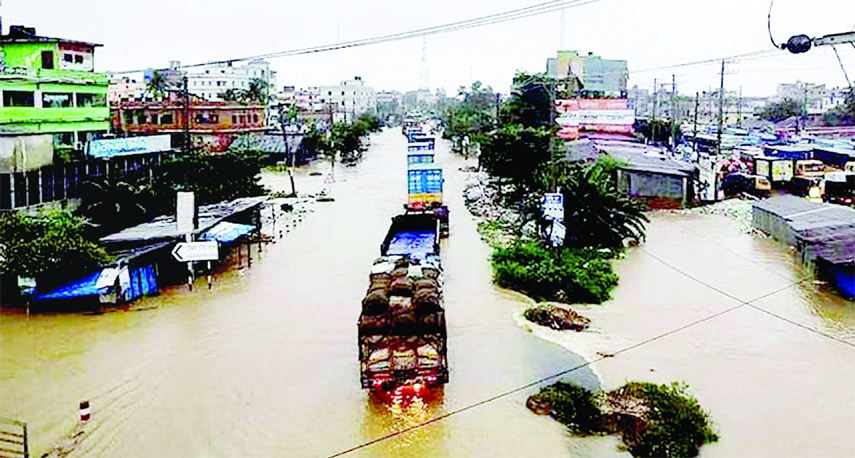Staff Reporter :
A devastating flood, caused by torrential rain and the opening of sluice gates in India, has severely impacted at least eight districts in the northeastern and eastern regions of the country.
The Ministry of Disaster Management and Relief reported on Thursday that over 30 lakh people are now suffering from the effects of the flooding, which has also led to significant losses in crops and fisheries.
The severe flooding has affected 357 unions across eight districts.
The worst-hit areas include the northern-central districts of Moulvibazar, Habiganj, and Brahmanbaria, along with the southeastern districts of Comilla, Feni, Chattogram, Khagrachari, and Noakhali.
As the floodwaters continue to rise, a staggering 440,840 families have been trapped, with a total of 2,904,964 people affected.
Tragically, two lives have already been lost including one in Feni and another in Brahmanbaria, according to the ministry.
The flooding has also caused major disruptions in transportation. Rail services between Chattogram and other parts of the country have been suspended due to fears that the railway bridge in Habiganj might become submerged.
Consequently, six trains traveling between Sylhet and Dhaka, as well as Chattogram, have been halted.
The Flood Forecasting and Warning Centre reported heavy to very heavy rainfall in the eastern parts of Cumilla, Brahmanbaria, and Feni districts, which border India’s Tripura state, as well as in the interior basins of Tripura province over the past 24 hours.
As a result, the flood situation in the lower areas of Moulvibazar, Habiganj, Feni, Cumilla, and Chattogram districts has deteriorated further.
Meteorological agencies have indicated that the trend of heavy rainfall in the northeastern region and adjacent uplands may decrease over the next 24 hours.
During this period, some improvement in the flood situation is expected in the lower areas near the Manu, Khoai, and Dhalai rivers in Moulvibazar and Habiganj districts.
Similarly, in the southeastern and eastern regions, the heavy rainfall trend is likely to decrease in the next 24 hours. Initial improvements are expected in the flood-affected lower areas adjacent to rivers such as Muhuri, Feni, Gomti, and Halda in the Feni, Comilla, and Chattogram districts.
Despite these forecasts, the situation remains dire in several areas. In Bandarban’s Naikhongchhari Upazila, over 400 families across eight villages in the Baishari union are stranded due to heavy rainfall and hill torrents.
The flooding has swept away livestock and caused extensive damage to homes, crops, and seedbeds.
The breach of the Haor River embankment in Akhaura, Brahmanbaria, has exacerbated flooding, submerging additional villages and increasing the distress of local residents.
The situation has become critical as the Gomti River in Cumilla has risen 70 centimetres above the danger mark, inundating homes in low-lying char areas.
There was a rapid rise in water levels from Wednesday morning to Thursday at 10 am, the river level increased by 58 centimetres-has heightened fears of further breaches, particularly as cracks along the riverbanks continue to develop.
The situation has been further aggravated by heavy rainfall in India’s Tripura, which has impacted 25 spots along the riverbanks in Adarsha Sadar, Burichang, Brahmanpara, Debidwar, and Muradnagar upazilas.
Additionally, low-lying areas in Chauddagram and Nangalkot have also been flooded, with homes, fish farms, and various projects severely affected.
Severe waterlogging has struck parts of Cumilla city, including Chakbazar, Kandirpar, Salauddin Mor, Chartha, Thakurpara, DC Road, and Bagichagaon, bringing daily life to a halt.
Khagrachhari, too, has been hit by renewed flooding in its low-lying areas, following continuous rainfall over the past 24 hours.
The affected regions include Ganjpara, Aparna Chowdhury Para, Rajyamani Para, Kaladeva, Bottoli, and Footbil, where homes have been submerged, leaving residents in dire straits.
Over 300 families have sought refuge in 99 shelter centres across the district.
The flooding has also disrupted road connections between Khagrachhari and Dighinala, as well as Langadu and Baghaichhari upazilas in Rangamati.
This marks the fourth flood event in Khagrachhari in the past two months.
In the Haor region of Kishoreganj, floodwater from India’s Tripura, flowing through the Khowai River in Habiganj, has entered the area, causing previously submerged roads and croplands to flood again.
Residents of Ashtagram, Itna, and Mithamoin upazilas are increasingly concerned about the potential for severe waterlogging.
The Khowai River, which originates in Tripura, has surged due to the recent heavy rainfall in India.
Water levels have exceeded 195 cm at the Machulia point in Habiganj and 231.7 cm at the Balla point on the India-Bangladesh border.
Despite the rising water levels, the Water Development Board (WDB) asserts there is no immediate threat of flooding in the Kishoreganj Haor area, as water levels remain below the flood limits. However, residents remain anxious.
Abdul Jabbar of Mithamain Upazila’s Kewarjord Union expressed his concerns, saying, “We are not yet affected by the rising water.
But if the water increases too much, then many of our land, houses, and animals will go underwater for sure.”
Shamim Hasnain, Executive Engineer of the WDB in Habiganj, provided some reassurance, stating, “Different areas of Habiganj have been flooded by upstream water from India. However, the flood situation will improve in a day or two.”
Matiur Rahman of the WDB in Kishoreganj also commented on the situation, noting that the water levels in upstream areas, including Habiganj, have begun to decrease.
“The water will increase in the Kishoreganj Haor area in the next two to one days,” he said.
In Habiganj, the Khowai River is currently flowing 192 cm above the danger level, with continuous rainfall and hill torrents from upstream India compounding the challenges for local communities.
At least four children have been reported missing after being swept away by floodwaters in Ramu, Cox’s Bazaar.
Despite extensive search operations by locals, the children have not yet been found.
The area has been severely affected by heavy rainfall and mountain runoff over the past two days, which has led to widespread flooding in the low-lying regions of Ramu.
More than fifty villages across the upazila have been submerged, with the situation becoming increasingly dire.




